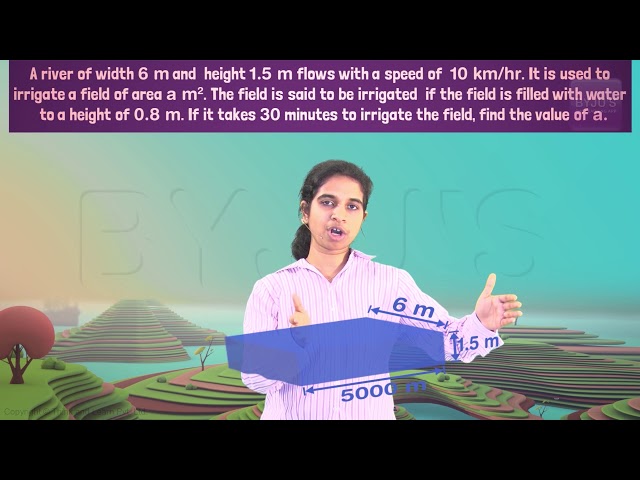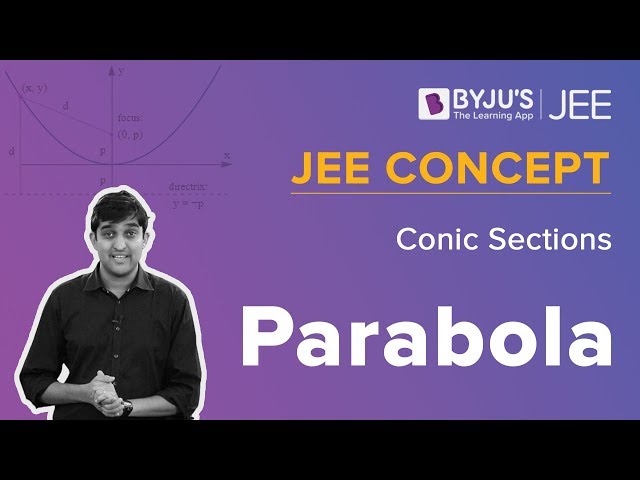a) 85
b) 95
c) 195
d) 185
Equation of tangent at (1, 7) to x2 = y-6 is 2x-y = -5.
It touches circle x2+y2+16x+12y+c = 0.
Hence length of perpendicular from centre (-8, -6) to tangent equals radius of circle.
d =
radius =
√(100-c) = √5
So c = 95
Answer: (b)
a) 1/2√2
b) 1/√2
c) 1/4√2
d) 1/3√2
L1 =
= l+m (drs of line L1)
L2 =
= 3l-5m-7n (drs of line L2)
Normal plane containing line L1 and L2 =
= 7l-7m-8n
For one point of line L1
2x-2y+3z-2 = 0
x-y+z+1 = 0
Put x = 0, and solving above equations we get (0, 5, 4)
So the equation of the plane is -7(x-0)+7(y-5)-8(z-4) = 0
7x-7y+8z+3 = 0
Distance =
= 3/√162
= 1/3√2
Answer: (d)
a) 1
b) 2
c) -1
d) 0
x2-x+1 = 0
x =
= (1±i√3)/2
= (1+i√3)/2 , (1-i√3)/2
= -(-1-i√3)/2, -(-1+i√3)/2
= -ω2, -ω
α= -ω2
β = -ω
α101+β107 = (-ω2)101+(-ω)107
= -(ω202+ ω107)
= -[(ω3)67 ω+ (ω3)35 ω2]
= -[ω +ω2]
= 1
Answer: (a)
a) 60√3
b) 36√5
c) 45√5
d) 54√3
Given equation of hyperbola is 4x2-y2 = 36
(x2/9)-(y2/36) = 1
a2 = 9
b2 = 36
From T(0, 3) tangents are drawn to hyperbola at P and Q.
Hence equation of Chord of contact PQ is
(x(0)/9) – (y(3)/36) = 1
y = -12
(x2/9)-(144/36) = 1
x2 = 45
x = ±3√5
Hence P = (3√5, -12) and Q = (-3√5, -12)
Hence ar(PQT) is
Answer: (c)
a) 4
b) 9/2
c) 6
d) 7/2
Given y2 = 6x
Differentiating
2y(dy/dx) = 6
(dy/dx) = 3/y
Given 9x2 + by2 = 16
Differentiating
18x+2by(dy/dx) = 0
(dy/dx) = -18x/2by
(dy/dx) = -9x/by
Let the intersection point be (x1, y1)
m1 = 3/y1
m2 = -9x1 /by1
Since the curves intersect at right angles, m1m2 = -1
(3/y1)( -9x1 /by1) = -1
27x1 = by12 [Since (x1, y1) lies on y2 = 6x y12 = 6x1]
27x1 = b(6x1)
b = 9/2
Answer: (b)
x+ky+3z = 0
3x+ky-2z = 0
2x+4y-3z = 0
has a non-zero solution (x, y, z), then xz/y2 is equal to :
a) -30
b) 30
c) -10
d) 10
Given system of equations have non zero solutions.
So, Δ =
1(-3k+8)-k(-9+4)+3(12-2k) = 0
-3k+8+5k+36-6k = 0
4k = 44
k = 44/4 = 11
Now the given equations become
x+11y+3z = 0
3x+11y-2z = 0
2x+4y-3z = 0
x/(-22-33) = y/(-(-2-9) = z/(11-33)
x/-55 = y/11 = x/-22
x/5 = y/-1 = z/2 = L (let)
xz/y2 = (5L)(2L)/(-L2) = 10
Answer: (d)
a) contains exactly two elements.
b) contains exactly four elements.
c) is an empty set.
d) contains exactly one element.
2|√x-3|+√x(√x-6)+6 = 0
2√x-6+x-6√x+6 = 0 if √x >3
x-4√x = 0
√x = 0 or 4
√x = 4
Also 2(3-√x)+√x(√x-6)+6 = 0 if √x<3
6-2√x+x-6√x+6 = 0
x-8√x+12 = 0
(√x)2-6√x-2√x+12 = 0
(√x-2)(√x-6) = 0
√x = 2, 6
x = 4
Answer: (a)
a) 8/9
b) 20/9
c) 2/3
d) 13/9
8cos x(cos ((π/6)+x). cos ((π/6)-(1/2))-(1/2)) = 1
8.cos x[(cos (π/3)+ cos 2x-2)/2] = 1
4 cosx(cos 2x-(1/2)) = 1
4 cosx(2cos2x-(3/2)) = 1
8cos3x-6cosx-1 = 0
2(4cos3x-3cosx)-1 = 0
2cos3x-1 = 0
cos 3x = 1/2 = cos(π/3)
3x = 2nπ ±π/3
x = (2nπ /3) ±(π/9)
= 7π/9, 5π/9, π/9 in [0, π]
k = 13/9
Answer: (d)
a) 1/5
b) 3/4
c) 3/10
d) 2/5

From total Probability Theorem
P (R) = (4/10)×(1/2)+(6/10) × (4/12)
= (1/5)+(1/5)
= 2/5
Answer: (d)
a) -2√2
b) 2√2
c) 3
d) -3
f(x) = x2+(1/x2)
= (x-(1/x))2+2
g(x) = x-(1/x)
Put x-(1/x) = t
h(x) = f(x)/g(x)
Let h(x) = k(t)
= (t2+2)/t
= t+2/t
Differentiating
k’(t) = 1-2/t2
For minima or maxima, 1-2/t2 = 0
t2 = 2
t = ±√2
k’’(t) = 4/t3
At t = √2, k’’(t) = 2/√2
At t = -√2, k’’(t) = -2/√2
At t = √2. k’’(t) is positive.
So it is a minima.
h(x) = t+2/t
= √2+2/√2
= 2√2
Answer: (b)
A = {(a,b) ∈R×R:|a-5| < 1 and |b-5| < 1}
B = {(a,b) ∈R×R: 4(a-6)2+9(b-5)2 ≤ 36}. Then:
a) A⋂B = phi(an empty set)
b) neither A⊂B nor B⊂A
c) B⊂A
d) A⊂B
A = {(a,b) ∈R×R:|a-5| < 1 and |b-5| < 1}
-1<a-5<1
4<a<6
4<b<6
B = {(a,b) ∈R×R
4(a-6)2+9(b-5)2 ≤ 36
((a-6)2 /9 )+((b-5)2 /4) ≤ 1

Answer: (d)
a) q
b) ~q
c) ~p
d) p
|
p (1) |
q (2) |
~p (3) |
(p ˅q) (4) |
~(p ˅q) (5) |
~p˄q (6) |
~(p ˅q) ˅(~p˄q) |
|
T |
T |
F |
T |
F |
F |
F |
|
T |
F |
F |
T |
F |
F |
F |
|
F |
T |
T |
T |
F |
T |
T |
|
F |
F |
T |
F |
T |
F |
T |
Entries in column (3) and (7) are identical.
Answer: (c)
a) 3
b) 4/3
c) 1/2
d) 2

Tangent and normal are drawn at P (16, 16) on y2 = 16x
y2 = 16x
Slope of tangent dy/dx = 16/2y
= 8/y
(dy/dx)(16,16) = 1/2
Equation of the tangent is
y-16 = (1/2)(x-16)
2y-32 = x-16
x-2y+16 = 0 ..(1)
Equation of normal
y-16 = -2(x-16)
2x+y-48 = 0 ..(2)
Tangent & normal intersect the axis of parabola
A(-16,0)
B(24,0)
Slope of AP×slope of PB
[(16-0)/(16+16)][(16-0)/(16-24)] = -1So AB is the diameter of circle with centre C(4,0)
mPC = (16-0)/(16-4) = 16/12 = 4/3
mPB = (16-0)/(16-24) = 16/-8 = -2
tan = m1 -m2/(1+m1m2)
= (4/3)+2)/(1+(4/3)×2)
= 2
Answer: (d)
a) (-4, 5)
b) (4, 5)
c) (-4, -5)
d) (-4, 3)

= (5x-4)(-1)(x+4)(x-4-2x)
= -1(5x-4)(x+4)(-x-4)
= (5x-4)(x+4)(x+4)2
= (-4+5x)(x-(-4))2
Hence A = -4, B = 5
Answer: (a)
a) 1
b) 2
c) -1
d) 0
(a+b)n+(a-b)n = 2(nC0an + nC2an-2b2+ nC4an-4b4…)
(x+√(x3-1))5+(x-√(x3-1))5, (x>)
= 2(5C0x5+5C2x3(√(x3-1))2+5C4x(√(x3-1))4)
= 2(x5+10x6-10x3+5x7-10x4+5x)
Sum of the coefficient of odd term is given by
2(1-10+5+5)
= 2
Answer: (b)
a) 34
b) 33
c) 66
d) 68
a1, a2, a3,..a49 are in A.P
Let A be the first term and D is the common difference.
a9+a43 = 66
A+8D+A+42D = 66
2A+50D = 66
A+25D = 33
a26 = 33 ..(i)
Ʃk=012 a4k+1 = 416
a1+a5+a9+…+a49 = 416
13A+312D = 416
A+24D = 23
a25 = 32 ..(ii)
From (i) and (ii), a26-a25 = D = 1
Also A+25D = 33
So A = 8
a12+a22+…+a172 = 82+92+102+…+242
Ʃr=124 r2– Ʃr=17 r2 = 140m
(24×25×49/6)-(7× 8 ×15/6) = 140m
4900-140 = 140m
m = 34
Answer: (a)
a) 3x+2y = xy
b) 3x+2y = 6xy
c) 3x+2y = 6
d) 2x+3y = xy

line y-3 = m(x-2)
y-3 = mx-2m
P = ((2m-3)/m, 0)
Q = (0, 3-2m)
Let R(α, β)
So α= ((2m-3)/m, 0) and β = 3-2m
m = 3/(2-α) and m = (3-β)/2
3/(2-α) = (3-β)/2
6 = 6-2β-3α+αβ
Locus of R (α,β) is 3x+2y = xy
Answer: (a)
a) 4π
b) π/4
c) π/8
d) π/2

Answer: (b)
a) (1/2)(√3-√2)
b) (1/2)(√2-1)
c) (1/2)(√3-1)
d) (1/2)(√3+1)
18x2-9πx+π2 = 0
x = π/6, π/3 (so α= π/6, β= π/3)
y = (gof)(x)
= g(f(x))
= g(√x)
= cos x
A =
= (√3/2)-(1/2)
= (√3-1)/2
Answer: (c)
a) is equal to 120
b) does not exist (in R)
c) is equal to 0
d) is equal to 15

Answer: (a)
a) 2
b) 3
c) 9
d) 4
Variance = (1/n) Ʃi=1n xi2-[(1/n) Ʃi=1n xi]2
= (1/9)×45-((1/9)×9)2
= 5-1
= 4
S.D = √4 = 2
Answer: (a)
where C is the constant of integration.
a) 1/(1+cot3x) + C
b) -1/(1+cot3x) + C
c) 1/3(1+tan3x) + C
d) -1/3(1+tan3x) + C

Answer: (d)
a) {π}
b) {0,π}
c) (an empty set)
d) {0}
f(x) = |x-π|(e|x|-1) sinx
Obviously differentiable at x = 0
Check at x = π

So, differentiable at x = π.
Answer: (c)
a) (-8/9)π2
b) (-4/9)π2
c) (4/9√3)π2
d) (-8/9√3)π2
(dy/dx)+y cotx = 4x/sin x
IF = e∫cot xdx = elog|sin x| = sin x as x∈(0,π)
y sin x = c+∫4x dx
= c+2x2
As y(π/2) = 0 0.sin(π/2) = c+2(π/2)2
c = -(π2/2)
So y sin x = 2x2-(π2/2)
Put x = π/6
y sin π/6 = 2(π/6)2-(π2/2)
y(1/2) = (π2/18)- (π2/2)
= (-8π2/9)
= (-8/9)π2
Answer: (a)
25. Let u be a vector coplanar with the vectors
and
a) 256
b) 84
c) 336
d) 315
As coplanar
4u1-2u2+2u3 = 0
2u1-u2+u3 = 0 ..(1)
2u1-3u2-u3 = 0 ..(2)
u2+u3= 24 ..(3)
Solving u1 = -4, u2 = 8, u3 = 16
Answer: (c)
a) 1/3
b) √(2/3)
c) 2/√3
d) 2/3

Direction ratios of AB = (1,0,1)
Let be angle between line AB and normal of plane.
So cos = 1×1+0×1+1×1)/√2√3
= √2/√3
So projection of line AB =
= √2×√(1-2/3)
= √(2/3)
Answer: (b)
a) 100√3
b) 50√2
c) 100
d) 50

Let TW = h
ΔPTW, tan 450 = h/y1
h = y1
Similarly, h/y2 = tan 300
y2 = √3h
ΔPQT, PQ2 = QT2+PT2
40000 = 3h2+h2
4h2 = 40000
h = 100
Answer: (c)
a) at least 500 but less than 750
b) at least 750 but less than 1000
c) at least 1000
d) less than 500
We have 6 novels and 3 dictionaries. We can select 4 novels and 1 dictionary in
6C4 ×3C1 = 6!×3/(4!2!)
= 6×5×3/2
= 45 ways.
Now 4 novels and 1 dictionary are to be arranged so that dictionary is always in middle. So remaining 4 novels can be arranged in 4! ways.
Hence total arrangements possible are
45×24 = 1080 ways
Answer: (c)
12 +2.22+32+2.42+52 + 2.62+..
If B-2A = 100λ, then λ is equal to :
a) 464
b) 496
c) 232
d) 248
B = (12+32+52+…+392)+2(22+42+…+402)
= (12+22+32+…+402)+(22+42+…+402)
= (12+22+32+…+402)+4(12+22+32+…+202)
A = (12+22+32+…+202)+4(12+22+32+…+102)
Using 12+22+..n2 = n(n+1)(2n+1)/6
B-2A = 24800
Hence λ = 248
Answer: (d)
a) 3√(5/2)
b) 3√5/2
c) √10
d) 2√10

As we know centroid divides line joining circumcentre and orthocentre internally 1:2.
So, C(6,2)
AC = √[(6+3)3+(2-5)2]
= √90
= 3√10
r = AC/2
= 3√10/2
= 3√(5/2)
Answer: (a)
Video Lessons – January 10 Shift 1 Maths




JEE Main 2018 Maths Paper With Solutions Shift 1 January 10




















Comments